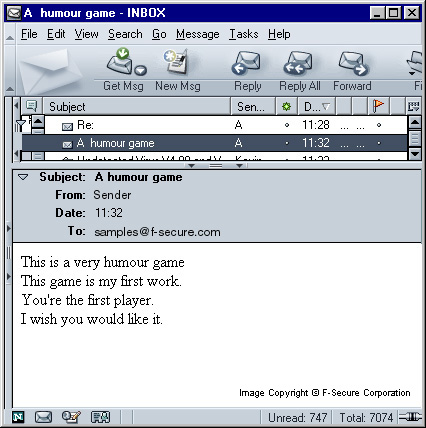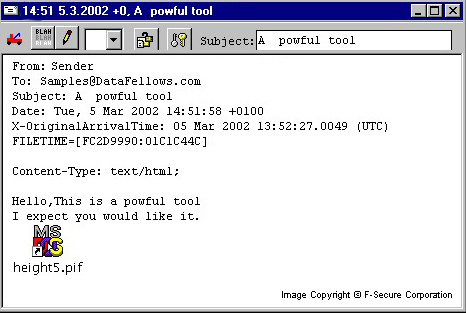Klez.E
Summary
Klez.E will destroy data on 6th of July by overwriting all files on local and network drives with random data.
The description of the original Klez variant can be found here:
Removal
Disinfection of Klez.E worm can be performed with the special tool that is available on our ftp site:
ftp://ftp.europe.f-secure.com/anti-virus/tools/kleztool.zip
Please read the KLEZTOOL.TXT file included in the ZIP archive before using the tool.
Removal help with Video
We have produced an online video showing step-by-step how to get rid of the Klez worm.
View the video (Real) from here:
https://www.f-secure.com/virus-info/video/klez.ram
You can download RealPlayer from here:

https://www.real.com/player/index.html?lang=en
For feedback on the video or further questions, contact support@f-secure.com
A False Positive is when a file is incorrectly detected as harmful, usually because its code or behavior resembles known harmful programs. A False Positive will usually be fixed in a subsequent database update without any action needed on your part. If you wish, you may also:
-
Check for the latest database updates
First check if your F-Secure security program is using the latest updates, then try scanning the file again.
-
Submit a sample
After checking, if you still believe the file is incorrectly detected, you can submit a sample of it for re-analysis.
Note: If the file was moved to quarantine, you need to collect the file from quarantine before you can submit it.
-
Exclude a file from further scanning
If you are certain that the file is safe and want to continue using it, you can exclude it from further scanning by the F-Secure security product.
Note: You need administrative rights to change the settings.
Technical Details
Klez.E is a new variant of Klez worm that was first discovered on 17th of January 2002. The worm is "version 2.0" according to its author's classification and has several new features comparing to the older variants. The worm still has bugs that remained from previous versions.
The differences from the original version are as follows:
1. The worm installs itself to Windows System directory as WINKxxxx.EXE file. The 'xxxx' can be 2-3 random letters. The worm creates an autostarting key for its file in System Registry.
2. The worm now has file infection capabilities. When infecting an EXE file, the worm overwrites it and creates a backup file with the same name as the infected file, but with a random extension with hidden, system and read-only attributes. When the infected file is run, the worm extracts the original program from a backup file with its original name plus 'MP8' and runs it. After the program terminates, the worm deletes it. The worm doesn't infect files with the following names:
EXPLORER CMMGR MSIMN ICWCONN WINZIP
This type of infection is called 'companion infection'.
3. The worm has network spreading capabilities. The worm enumerates network resources and copies itself to remote drives twice - once as an executable file with single or double extension, and second time as a RAR archive that can have single or double extension as well. The RAR archive contains the worm's executable file with one of the following names:
setup install demo snoopy picacu kitty play rock
The first extension of the RAR archive or of the worm's executable can be:
.txt .htm .html .wab .doc .xls .jpg .cpp .c .pas .mpg .mpeg .bak .mp3
The second or the only extension of the worm's executable file can be:
.exe .scr .pif .bat
The dropped RAR archive and worm's executable file name is either random or belongs to a file, that a worm found on a host system. So it can be for example QQ.PAS.EXE , KERNEL.MP3.PIF , DOCUMENT.SCR and so on.
4. The worm kills tasks of anti-virus and security software as well as tasks of several other worms - Nimda, Sircam, Funlove and CodeRed. The worm opens processes and looks for the specific text strings there. If a specific text string is found in a process, the worm terminates this process. The strings the worm looks for are:
Sircam Nimda CodeRed WQKMM3878 GRIEF3878 Fun Loving Criminal Norton Mcafee Antivir Avconsol F-STOPW F-Secure Sophos virus AVP Monitor AVP Updates InoculateIT PC-cillin Symantec Trend Micro F-PROT NOD32
Also the worm terminates processes with the following names:
_AVP32 _AVPCC NOD32 NPSSVC NRESQ32 NSCHED32 NSCHEDNT NSPLUGIN NAV NAVAPSVC NAVAPW32 NAVLU32 NAVRUNR NAVW32 _AVPM ALERTSVC AMON AVP32 AVPCC AVPM N32SCANW NAVWNT ANTIVIR AVPUPD AVGCTRL AVWIN95 SCAN32 VSHWIN32 F-STOPW F-PROT95 ACKWIN32 VETTRAY VET95 SWEEP95 PCCWIN98 IOMON98 AVPTC AVE32 AVCONSOL FP-WIN DVP95 F-AGNT95 CLAW95 NVC95 SCAN VIRUS LOCKDOWN2000 Norton Mcafee Antivir TASKMGR
5. The worm removes autostarting Registry keys of security and anti-virus software thus disabling this software or parts of it completely on next Windows startup.
6. The worm affects anti-virus checksum files and ingegrity checker databases with the following names:
ANTI-VIR.DAT CHKLIST.DAT CHKLIST.MS CHKLIST.CPS CHKLIST.TAV IVB.NTZ SMARTCHK.MS SMARTCHK.CPS AVGQT.DAT AGUARD.DAT
7. The worm drops a new version of Elkern virus ("version 1.1" according to author's classification) that is also known as Win32.Klez.b. Please see Elkern description for more info, the link to it is on the top of this page.
8. The worm can corrupt binary executables and data files.
9. The worm contains the following text strings that are never displayed:
Win32 Klez V2.0 & Win32 Elkern V1.1,(There nick name is Twin Virus*^__^*) Copyright,made in Asia,announcement: 1.I will try my best to protect the user from some vicious virus,Funlove,Sircam,Nimda,CodeRed and even include W32.Klez 1.X. 2.Well paid jobs are wanted 3.Poor life should be unblessed 4.Don't accuse me.Please accuse the unfair sh*t world
10. The worm has a complex payload routine. It works as a separate thread and constantly checks system date. If the month number is odd (1, 3, 5, etc.) and the date is equal to 6 then the worm proceeds further. It then checks if the month number is equal to 7 (July) or 1 (January) and sets a special flag if it is. Then the main payload routine is activated. It looks for all files on all local and network drives. If the month is not 1 or 7, the routine only affects files with the following extensions:
txt htm html wab doc xls jpg cpp c pas mpg mpeg bak mp3
Otherwise all files are affected. The worm overwrites found files with random data thus destroying their content.
11. email messages sent by Klez.e are composed according to really complex rules that makes possible of creating a large number of different messages. It can create sentences from different parts like:
'The attachment is a very dangerous virus that spread trough email.' 'The file is a special dangerous virus that can infect on Win98/Me/2000/XP.'
Just like the other variants of Klez this one uses the Incorrect MIME Header (MS01-020) vulnerabilty to send attachments that are automatically executed when the message is opened. See the link to Microsoft security advisory above.
Recipients' email addresses are collected from the Windows Address Book as well as from ICQ user databases. The worm uses it's own SMTP routines so it can send email without an email client.
Important Note: The emails sent by Klez.E worm often have faked sender's address. The worm randomly picks sender's address from web pages, ICQ databases or Windows Address Books. This means that if you get Klez.E worm in email, it's quite likely that it was NOT sent to you by the person listed in the 'From' field of email message (sender's address).
The worm can send itself in messages with one the following subjects:
how are you let's be friends darling don't drink too much your password honey some questions please try again welcome to my hometown the Garden of Eden introduction on ADSL meeting notice questionnaire congratulations sos! japanese girl VS playboy look,my beautiful girl friend eager to see you spice girls' vocal concert japanese lass' sexy pictures
Also the worm sometimes sends messages pretending to be infection removal tools from a few anti-virus companies. For example:
Subject:removal tools Body: is a dangerous virus that spread through email. give you the removal tools For more information,please visit http://www. .com
The <av_company_name> can be 'Symantec', 'Mcafee', 'F-Secure' or 'Sophos'. The <virusname> can be 'W32.Elkern' or 'W32.Klez'. Do not run attachments from such messages!
Also the worm can pretend to be a game, it can send itself (usually as SETUP.EXE or INSTALL.EXE) with the a message:
Subject: removal tools Body: is a dangerous virus that spread through email. give you the removal tools For more information,please visit http://www..com
Sometimes the virus compares current date against a preset list of 10 different holiday dates. If the date matches, the worm will send an email with a subject field such as "Happy Christmas", "Have a nice Christmas" or "Have a good Christmas". There are several variations on the exact subject field.
This only happens on one day per year for each of the holidays - for Christmas, Klez only tries to send these messages on 25th of December. Explanation for getting these messages before Christmas is simply that lots of people have their computers date set wrong.
The holidays are:
Subject: removal tools Body: is a dangerous virus that spread through email. give you the removal tools For more information,please visit http://www..com
Here are the screenshots of Klez.E worm as it arrives in email:


12. The worm corrupts a lot of system files including DLL and VXD ones that often makes a system unusable after restart. The corruption happens because the worm tries to preserve the time/date stamp of a file it tries to infect and it saves this value into EXE file header without bothering to check if it's a PE, NE or LE header. So NE and LE headers get corrupted and a file usually becomes unusable after that.